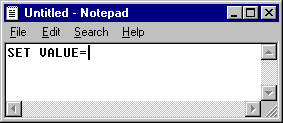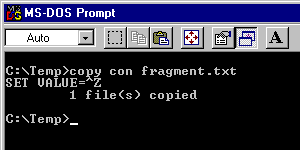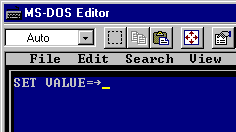Manually Creating Line Fragments
A line fragment is a text line without the terminating
CR/LF. Line fragments may be added to the beginning of regular lines to
create a new longer line.
Creating a line fragment ahead of time is immensely popular. This is
a "Make it once and use it forever" kind of thing. Once you have a line
fragment, you can concatenate it with another line to join the two into
a new (batch file!) single line. It's as simple as using COPY:
copy fragment.txt + someline.txt newline.bat
 The
easiest "ahead of time" technique is to use any decent word processor to
create your fragment. In the picture shown here, I'm creating a fragment
that says SET VALUE=. You could just as easily have it specify another
batch file. No matter. The trick is to leave your cursor (shown as a vertical
bar in this example) at the end of the line. Absolutely don't hit "Enter".
In fact, hit the "Delete" key a few times just to make sure there are no
invisible carriage returns. If you hit your right arrow key, your cursor
shouldn't move. If you're there, all you have to do is save what you have
as plain text (which is all Notepad can do anyway).
The
easiest "ahead of time" technique is to use any decent word processor to
create your fragment. In the picture shown here, I'm creating a fragment
that says SET VALUE=. You could just as easily have it specify another
batch file. No matter. The trick is to leave your cursor (shown as a vertical
bar in this example) at the end of the line. Absolutely don't hit "Enter".
In fact, hit the "Delete" key a few times just to make sure there are no
invisible carriage returns. If you hit your right arrow key, your cursor
shouldn't move. If you're there, all you have to do is save what you have
as plain text (which is all Notepad can do anyway).
 DOS
diehards (that's you, right?) will prefer to create the fragment ahead
of time using DOS. We can do it by copying
the console (the keyboard) into a file. Of
course, we can't hit the "Enter" key at the end of the line (bet you guessed
that). Instead, hit ctrl-z (hold the "Ctrl" key down, then hit the "z"
key). After that you can hit the Enter key. That's all there is to it.
DOS
diehards (that's you, right?) will prefer to create the fragment ahead
of time using DOS. We can do it by copying
the console (the keyboard) into a file. Of
course, we can't hit the "Enter" key at the end of the line (bet you guessed
that). Instead, hit ctrl-z (hold the "Ctrl" key down, then hit the "z"
key). After that you can hit the Enter key. That's all there is to it.
 Most
people think it can't be done with EDIT, but it can! You see, EDIT has
an anoying habit of appending a carriage-return / linefeed pair to every
file it saves. No stopping it. But just like doing it from the DOS prompt,
the trick is to get a control-z into the file. Control-z characters are
(were) used to mark the end of a file. Sticking one in with EDIT is a deeply-buried
trick. First you have to hit Ctrl-p. That turns on a software switch which
allows you to enter a single control character in the file. You can then
enter your control-z one of two ways: Either hold down the "Ctrl" key and
hit "z" --or-- hold down the "Alt" key while entering "026" on the numeric
keypad. If it works, you'll see the cool little right arrow.
Most
people think it can't be done with EDIT, but it can! You see, EDIT has
an anoying habit of appending a carriage-return / linefeed pair to every
file it saves. No stopping it. But just like doing it from the DOS prompt,
the trick is to get a control-z into the file. Control-z characters are
(were) used to mark the end of a file. Sticking one in with EDIT is a deeply-buried
trick. First you have to hit Ctrl-p. That turns on a software switch which
allows you to enter a single control character in the file. You can then
enter your control-z one of two ways: Either hold down the "Ctrl" key and
hit "z" --or-- hold down the "Alt" key while entering "026" on the numeric
keypad. If it works, you'll see the cool little right arrow.
Lost? Look at the site map.
Bad links? Questions? Send me mail.
 The
easiest "ahead of time" technique is to use any decent word processor to
create your fragment. In the picture shown here, I'm creating a fragment
that says SET VALUE=. You could just as easily have it specify another
batch file. No matter. The trick is to leave your cursor (shown as a vertical
bar in this example) at the end of the line. Absolutely don't hit "Enter".
In fact, hit the "Delete" key a few times just to make sure there are no
invisible carriage returns. If you hit your right arrow key, your cursor
shouldn't move. If you're there, all you have to do is save what you have
as plain text (which is all Notepad can do anyway).
The
easiest "ahead of time" technique is to use any decent word processor to
create your fragment. In the picture shown here, I'm creating a fragment
that says SET VALUE=. You could just as easily have it specify another
batch file. No matter. The trick is to leave your cursor (shown as a vertical
bar in this example) at the end of the line. Absolutely don't hit "Enter".
In fact, hit the "Delete" key a few times just to make sure there are no
invisible carriage returns. If you hit your right arrow key, your cursor
shouldn't move. If you're there, all you have to do is save what you have
as plain text (which is all Notepad can do anyway).
 DOS
diehards (that's you, right?) will prefer to create the fragment ahead
of time using DOS. We can do it by copying
the console (the keyboard) into a file. Of
course, we can't hit the "Enter" key at the end of the line (bet you guessed
that). Instead, hit ctrl-z (hold the "Ctrl" key down, then hit the "z"
key). After that you can hit the Enter key. That's all there is to it.
DOS
diehards (that's you, right?) will prefer to create the fragment ahead
of time using DOS. We can do it by copying
the console (the keyboard) into a file. Of
course, we can't hit the "Enter" key at the end of the line (bet you guessed
that). Instead, hit ctrl-z (hold the "Ctrl" key down, then hit the "z"
key). After that you can hit the Enter key. That's all there is to it.
 Most
people think it can't be done with EDIT, but it can! You see, EDIT has
an anoying habit of appending a carriage-return / linefeed pair to every
file it saves. No stopping it. But just like doing it from the DOS prompt,
the trick is to get a control-z into the file. Control-z characters are
(were) used to mark the end of a file. Sticking one in with EDIT is a deeply-buried
trick. First you have to hit Ctrl-p. That turns on a software switch which
allows you to enter a single control character in the file. You can then
enter your control-z one of two ways: Either hold down the "Ctrl" key and
hit "z" --or-- hold down the "Alt" key while entering "026" on the numeric
keypad. If it works, you'll see the cool little right arrow.
Most
people think it can't be done with EDIT, but it can! You see, EDIT has
an anoying habit of appending a carriage-return / linefeed pair to every
file it saves. No stopping it. But just like doing it from the DOS prompt,
the trick is to get a control-z into the file. Control-z characters are
(were) used to mark the end of a file. Sticking one in with EDIT is a deeply-buried
trick. First you have to hit Ctrl-p. That turns on a software switch which
allows you to enter a single control character in the file. You can then
enter your control-z one of two ways: Either hold down the "Ctrl" key and
hit "z" --or-- hold down the "Alt" key while entering "026" on the numeric
keypad. If it works, you'll see the cool little right arrow.